Electrothermally Self-Healing Delamination Cracks in Carbon/Epoxy Composites Using Sandwich and Tough Carbon Nanotube/Copolymer Interleaves
Abstract
:1. Introduction
2. Materials and Methods
2.1. Materials
2.2. Preparation
2.3. Characterization
3. Results and Discussion
3.1. Self-Healing Mechanism
3.2. Microstructures
3.3. Toughening and Self-Healing of GIC
3.4. Toughening and Self-Healing of GIIC
4. Conclusions
Supplementary Materials
Author Contributions
Funding
Institutional Review Board Statement
Informed Consent Statement
Data Availability Statement
Conflicts of Interest
References
- Jony, B.; Mulani, S.B.; Roy, S. Interlaminar shear fracture healing of thermoset CFRP composite using multiphase thermoplastic healing agents. Compos. Struct. 2022, 279, 114807. [Google Scholar] [CrossRef]
- Cescato, R.; Rigotti, D.; Mahmood, H.; Dorigato, A.; Pegoretti, A. Thermal Mending of Electroactive Carbon/Epoxy Laminates Using a Porous Poly(epsilon-caprolactone) Electrospun Mesh. Polymers 2021, 13, 2723. [Google Scholar] [CrossRef] [PubMed]
- Kostopoulos, V.; Kotrotsos, A.; Baltopoulos, A.; Tsantzalis, S.; Tsokanas, P.; Loutas, T.; Bosman, A.W. Mode II fracture toughening and healing of composites using supramolecular polymer interlayers. Express Polym. Lett. 2016, 10, 914–926. [Google Scholar] [CrossRef]
- Alam, P.; Mamalis, D.; Robert, C.; Floreani, C.; Bradaigh, C.M.O. The fatigue of carbon fibre reinforced plastics—A review. Compos. B Eng. 2019, 166, 555–579. [Google Scholar] [CrossRef] [Green Version]
- Yang, G.; Feng, X.; Wang, W.; OuYang, Q.; Liu, L. Effective interlaminar reinforcing and delamination monitoring of carbon fibrous composites using a novel nano-carbon woven grid. Compos. Sci. Technol. 2021, 213, 108959. [Google Scholar] [CrossRef]
- Wang, C.H.; Gunnion, A.J. On the design methodology of scarf repairs to composite laminates. Compos. Sci. Technol. 2008, 68, 35–46. [Google Scholar] [CrossRef]
- Dorworth, L.; Gardiner, G. Repair of composite structures—A review. J. Adv. Mater. 2007, 39, 3–13. [Google Scholar]
- Islam, S.; Bhat, G. Progress and challenges in self-healing composite materials. Mater. Adv. 2021, 2, 1896–1926. [Google Scholar] [CrossRef]
- Wu, P.; Liu, L.; Wu, Z. Synthesis of Diels-Alder Reaction-Based Remendable Epoxy Matrix and Corresponding Self-healing Efficiency to Fibrous Composites. Macromol. Mater. Eng. 2020, 305, 2000359. [Google Scholar] [CrossRef]
- Paolillo, S.; Bose, R.K.; Santana, M.H.; Grande, A.M. Intrinsic Self-Healing Epoxies in Polymer Matrix Composites (PMCs) for Aerospace Applications. Polymers 2021, 13, 201. [Google Scholar] [CrossRef]
- Li, Y.; Yang, Z.; Zhang, J.; Ding, L.; Pan, L.; Huang, C.; Zheng, X.; Zeng, C.; Lin, C. Novel polyurethane with high self-healing efficiency for functional energetic composites. Polym. Test. 2019, 76, 82–89. [Google Scholar] [CrossRef]
- Agrawal, N.; Arora, B. Self-Healing Polymers and Composites: Extrinsic Routes. Mini-Rev. Org. Chem. 2022, 19, 496–512. [Google Scholar] [CrossRef]
- Romero-Sabat, G.; Gago-Benedí, E.; Roa Rovira, J.J.; González-Gálvez, D.; Mateo, A.; Medel, S.; Tolentino Chivite, A. Development of a highly efficient extrinsic and autonomous self-healing polymeric system at low and ultra-low temperatures for high-performance applications. Compos. Part A Appl. Sci. Manuf. 2021, 145, 106335. [Google Scholar] [CrossRef]
- Varley, R.J.; Parn, G.P. Thermally activated healing in a mendable resin using a non woven EMAA fabric. Compos. Sci. Technol. 2012, 72, 453–460. [Google Scholar] [CrossRef]
- Cohades, A.; Branfoot, C.; Rae, S.; Bond, I.; Michaud, V. Progress in Self-Healing Fiber-Reinforced Polymer Composites. Adv. Mater. Interfaces 2018, 5, 1800177. [Google Scholar] [CrossRef]
- Srinivas, M.; Yelamasetti, B.; Vishnu Vardhan, T.; Mohammed, R. A critical review on self-healing composites. Mater. Today Proc. 2021, 46, 890–895. [Google Scholar] [CrossRef]
- OuYang, Q.; Wang, X.; Liu, L. High crack self-healing efficiency and enhanced free-edge delamination resistance of carbon fibrous composites with hierarchical interleaves. Compos. Sci. Technol. 2022, 217, 109115. [Google Scholar] [CrossRef]
- Pingkarawat, K.; Bhat, T.; Craze, D.A.; Wang, C.H.; Varley, R.J.; Mouritz, A.P. Healing of carbon fibre–epoxy composites using thermoplastic additives. Polym. Chem. 2013, 4, 5007. [Google Scholar] [CrossRef]
- Pingkarawat, K.; Wang, C.H.; Varley, R.J.; Mouritz, A.P. Mechanical properties of mendable composites containing self-healing thermoplastic agents. Compos. Part A Appl. Sci. Manuf. 2014, 65, 10–18. [Google Scholar] [CrossRef]
- Pingkarawat, K.; Dell’Olio, C.; Varley, R.J.; Mouritz, A.P. Poly(ethylene- co -methacrylic acid) (EMAA) as an efficient healing agent for high performance epoxy networks using diglycidyl ether of bisphenol A (DGEBA). Polymer 2016, 92, 153–163. [Google Scholar] [CrossRef]
- Meure, S.; Wu, D.-Y.; Furman, S.A. FTIR study of bonding between a thermoplastic healing agent and a mendable epoxy resin. Vib. Spectrosc. 2010, 52, 10–15. [Google Scholar] [CrossRef]
- Azevedo do Nascimento, A.; Fernandez, F.; da Silva, F.S.; Ferreira, E.P.C.; Melo, J.D.D.; Cysne Barbosa, A.P. Addition of poly (ethylene-co-methacrylic acid) (EMAA) as self-healing agent to carbon-epoxy composites. Compos. Part A Appl. Sci. Manuf. 2020, 137, 106016. [Google Scholar] [CrossRef]
- Shanmugam, L.; Naebe, M.; Kim, J.; Varley, R.J.; Yang, J. Recovery of Mode I self-healing interlaminar fracture toughness of fiber metal laminate by modified double cantilever beam test. Compos. Commun. 2019, 16, 25–29. [Google Scholar] [CrossRef] [Green Version]
- Wang, C.H.; Sidhu, K.; Yang, T.; Zhang, J.; Shanks, R. Interlayer self-healing and toughening of carbon fibre/epoxy composites using copolymer films. Compos. Part A Appl. Sci. Manuf. 2012, 43, 512–518. [Google Scholar] [CrossRef]
- Meure, S.; Furman, S.; Khor, S. Poly[ethylene-co-(methacrylic acid)] Healing Agents for Mendable Carbon Fiber Laminates. Macromol. Mater. Eng. 2010, 295, 420–424. [Google Scholar] [CrossRef]
- Varley, R.J.; Charve, F. EMAA as a healing agent for mendable high temperature epoxy amine thermosets. Compos. Part A Appl. Sci. Manuf. 2012, 43, 1073–1080. [Google Scholar] [CrossRef]
- Hargou, K.; Pingkarawat, K.; Mouritz, A.P.; Wang, C.H. Ultrasonic activation of mendable polymer for self-healing carbon–epoxy laminates. Compos. B Eng. 2013, 45, 1031–1039. [Google Scholar] [CrossRef]
- Pingkarawat, K.; Mouritz, A.P. Stitched mendable composites: Balancing healing performance against mechanical performance. Compos. Struct. 2015, 123, 54–64. [Google Scholar] [CrossRef]
- Pingkarawat, K.; Wang, C.H.; Varley, R.J.; Mouritz, A.P. Healing of fatigue delamination cracks in carbon–epoxy composite using mendable polymer stitching. J. Intell. Mater. Syst. Struct. 2013, 25, 75–86. [Google Scholar] [CrossRef]
- Pingkarawat, K.; Wang, C.H.; Varley, R.J.; Mouritz, A.P. Effect of mendable polymer stitch density on the toughening and healing of delamination cracks in carbon–epoxy laminates. Compos. Part A Appl. Sci. Manuf. 2013, 50, 22–30. [Google Scholar] [CrossRef]
- Yang, T.; Wang, C.H.; Zhang, J.; He, S.; Mouritz, A.P. Toughening and self-healing of epoxy matrix laminates using mendable polymer stitching. Compos. Sci. Technol. 2012, 72, 1396–1401. [Google Scholar] [CrossRef]
- Ladani, R.B.; Pingkarawat, K.; Nguyen, A.T.T.; Wang, C.H.; Mouritz, A.P. Delamination toughening and healing performance of woven composites with hybrid z-fibre reinforcement. Compos. Part A Appl. Sci. Manuf. 2018, 110, 258–267. [Google Scholar] [CrossRef]
- Ladani, R.B.; Nguyen, A.T.T.; Wang, C.H.; Mouritz, A.P. Mode II interlaminar delamination resistance and healing performance of 3D composites with hybrid z-fibre reinforcement. Compos. Part A Appl. Sci. Manuf. 2019, 120, 21–32. [Google Scholar] [CrossRef]
- Loh, T.W.; Ladani, R.B.; Orifici, A.; Kandare, E. Ultra-tough and in-situ repairable carbon/epoxy composite with EMAA. Compos. Part A Appl. Sci. Manuf. 2021, 143, 106206. [Google Scholar] [CrossRef]
- Loh, T.W.; Ladani, R.B.; Ravindran, A.; Das, R.; Kandare, E.; Mouritz, A.P. Z-Pinned composites with combined delamination toughness and delamination Self-Repair properties. Compos. Part A Appl. Sci. Manuf. 2021, 149, 106566. [Google Scholar] [CrossRef]
- Gao, Y.; Liu, L.; Wu, Z.; Zhong, Z. Toughening and self-healing fiber-reinforced polymer composites using carbon nanotube modified poly (ethylene-co-methacrylic acid) sandwich membrane. Compos. Part A Appl. Sci. Manuf. 2019, 124, 105510. [Google Scholar] [CrossRef]
- Orellana, J.; Moreno-Villoslada, I.; Bose, R.K.; Picchioni, F.; Flores, M.E.; Araya-Hermosilla, R. Self-Healing Polymer Nanocomposite Materials by Joule Effect. Polymers 2021, 13, 649. [Google Scholar] [CrossRef] [PubMed]
- Mas, B.; Fernández-Blázquez, J.P.; Duval, J.; Bunyan, H.; Vilatela, J.J. Thermoset curing through Joule heating of nanocarbons for composite manufacture, repair and soldering. Carbon 2013, 63, 523–529. [Google Scholar] [CrossRef]
- Xu, X.K.; Zhang, Y.; Jiang, J.; Wang, H.; Zhao, X.L.; Li, Q.W.; Lu, W.B. In-situ curing of glass fiber reinforced polymer composites via resistive heating of carbon nanotube films. Compos. Sci. Technol. 2017, 149, 20–27. [Google Scholar] [CrossRef]
- Yao, X.; Hawkins, S.C.; Falzon, B.G. An advanced anti-icing/de-icing system utilizing highly aligned carbon nanotube webs. Carbon 2018, 136, 130–138. [Google Scholar] [CrossRef] [Green Version]
- Willocq, B.; Bose, R.K.; Khelifa, F.; Garcia, S.J.; Dubois, P.; Raquez, J.M. Healing by the Joule effect of electrically conductive poly(ester-urethane)/carbon nanotube nanocomposites. J. Mater. Chem. A 2016, 4, 4089–4097. [Google Scholar] [CrossRef]
- Araya-Hermosilla, R.; Pucci, A.; Raffa, P.; Santosa, D.; Pescarmona, P.P.; Gengler, R.Y.N.; Rudolf, P.; Moreno-Villoslada, I.; Picchioni, F. Electrically-Responsive Reversible Polyketone/MWCNT Network through Diels-Alder Chemistry. Polymers 2018, 10, 1076. [Google Scholar] [CrossRef] [PubMed] [Green Version]
- Lima, G.M.R.; Orozco, F.; Picchioni, F.; Moreno-Villoslada, I.; Pucci, A.; Bose, R.K.; Araya-Hermosilla, R. Electrically Self-Healing Thermoset MWCNTs Composites Based on Diels-Alder and Hydrogen Bonds. Polymers 2019, 11, 1885. [Google Scholar] [CrossRef] [Green Version]
- Le, H.H.; Hait, S.; Das, A.; Wiessner, S.; Stockelhuber, K.W.; Bohme, F.; Reuter, U.; Naskar, K.; Heinrich, G.; Radusch, H.J. Self-healing properties of carbon nanotube filled natural rubber/bromobutyl rubber blends. Express Polym. Lett. 2017, 11, 230–242. [Google Scholar] [CrossRef]
- Le, H.H.; Boehme, F.; Sallat, A.; Wiessner, S.; Landwehr, M.A.D.; Reuter, U.; Stoeckelhuber, K.-W.; Heinrich, G.; Radusch, H.-J.; Das, A. Triggering the Self-Healing Properties of Modified Bromobutyl Rubber by Intrinsically Electrical Heating. Macromol. Mater. Eng. 2017, 302, 1600385. [Google Scholar] [CrossRef]
- Kim, H.; Yarin, A.L.; Lee, M.W. Self-healing corrosion protection film for marine environment. Compos. B Eng. 2020, 182, 107598. [Google Scholar] [CrossRef]
- Yang, B.; Xuan, F.-Z.; Wang, Z.; Chen, L.; Lei, H.; Liang, W.; Xiang, Y.; Yang, K. Multi-functional interface sensor with targeted IFSS enhancing, interface monitoring and self-healing of GF/EVA thermoplastic composites. Compos. Sci. Technol. 2018, 167, 86–95. [Google Scholar] [CrossRef]
- Joo, S.-J.; Yu, M.-H.; Kim, W.S.; Kim, H.-S. Damage detection and self-healing of carbon fiber polypropylene (CFPP)/carbon nanotube (CNT) nano-composite via addressable conducting network. Compos. Sci. Technol. 2018, 167, 62–70. [Google Scholar] [CrossRef]
- Jimenez-Suarez, A.; Martin-Gonzalez, J.; Sanchez-Romate, X.F.; Prolongo, S.G. Carbon nanotubes to enable autonomous and volumetric self-heating in epoxy/polycaprolactone blends. Compos. Sci. Technol. 2020, 199, 108321. [Google Scholar] [CrossRef]
- Kim, H.; Yarin, A.L.; Lee, M.W. Ultra-fast bull’s eye-like self-healing using CNT heater. Polymer 2019, 180, 121710. [Google Scholar] [CrossRef]
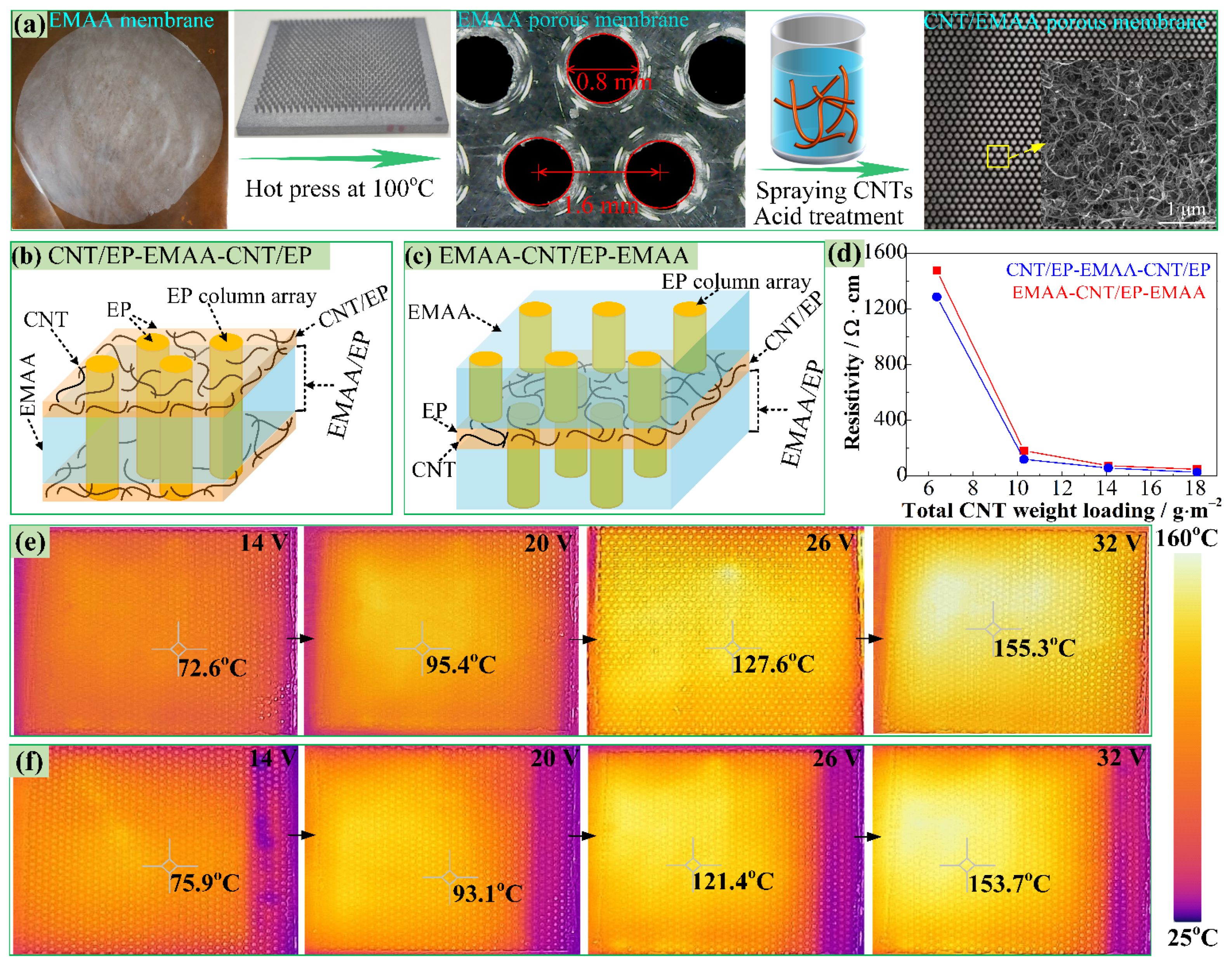

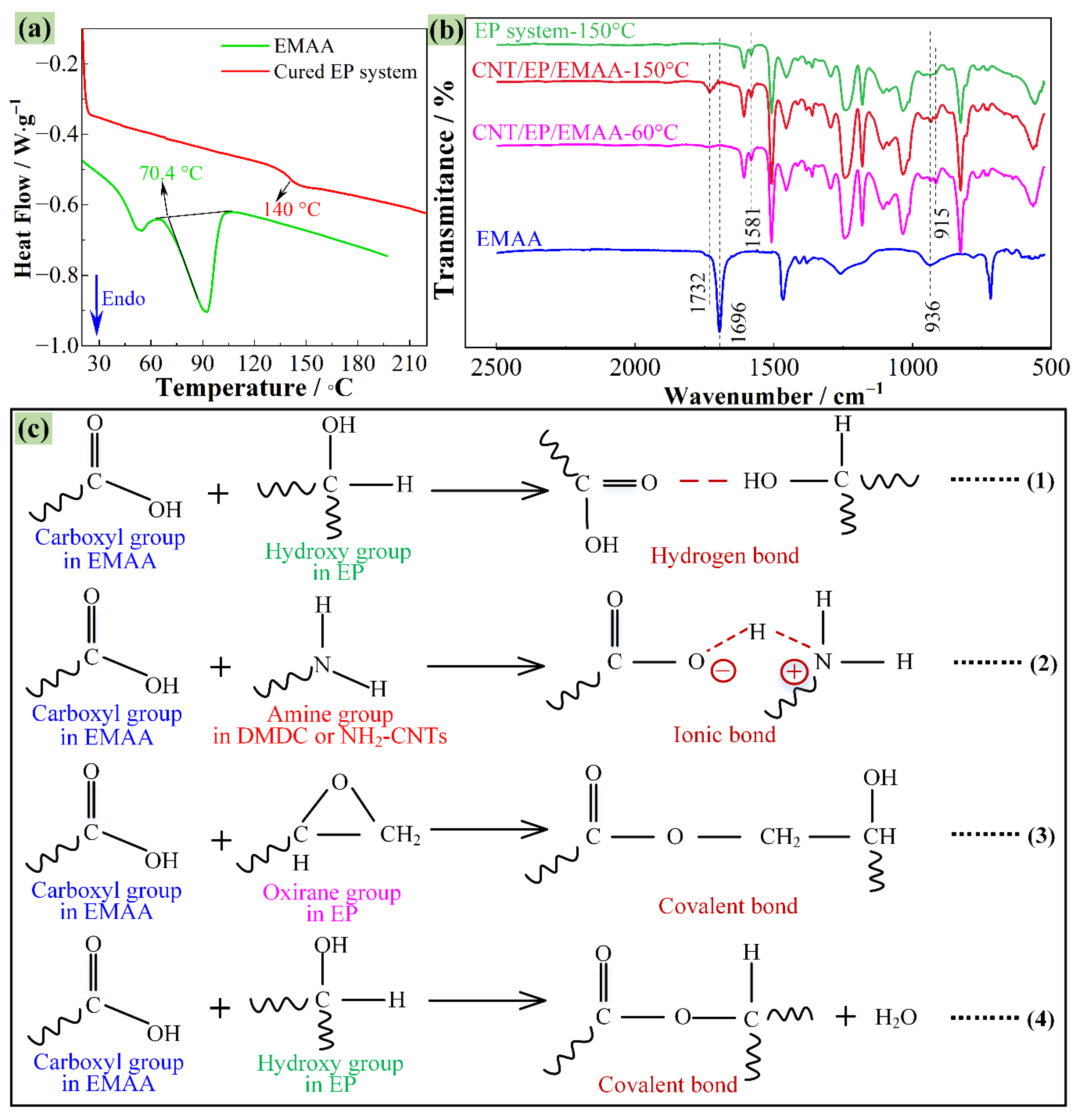


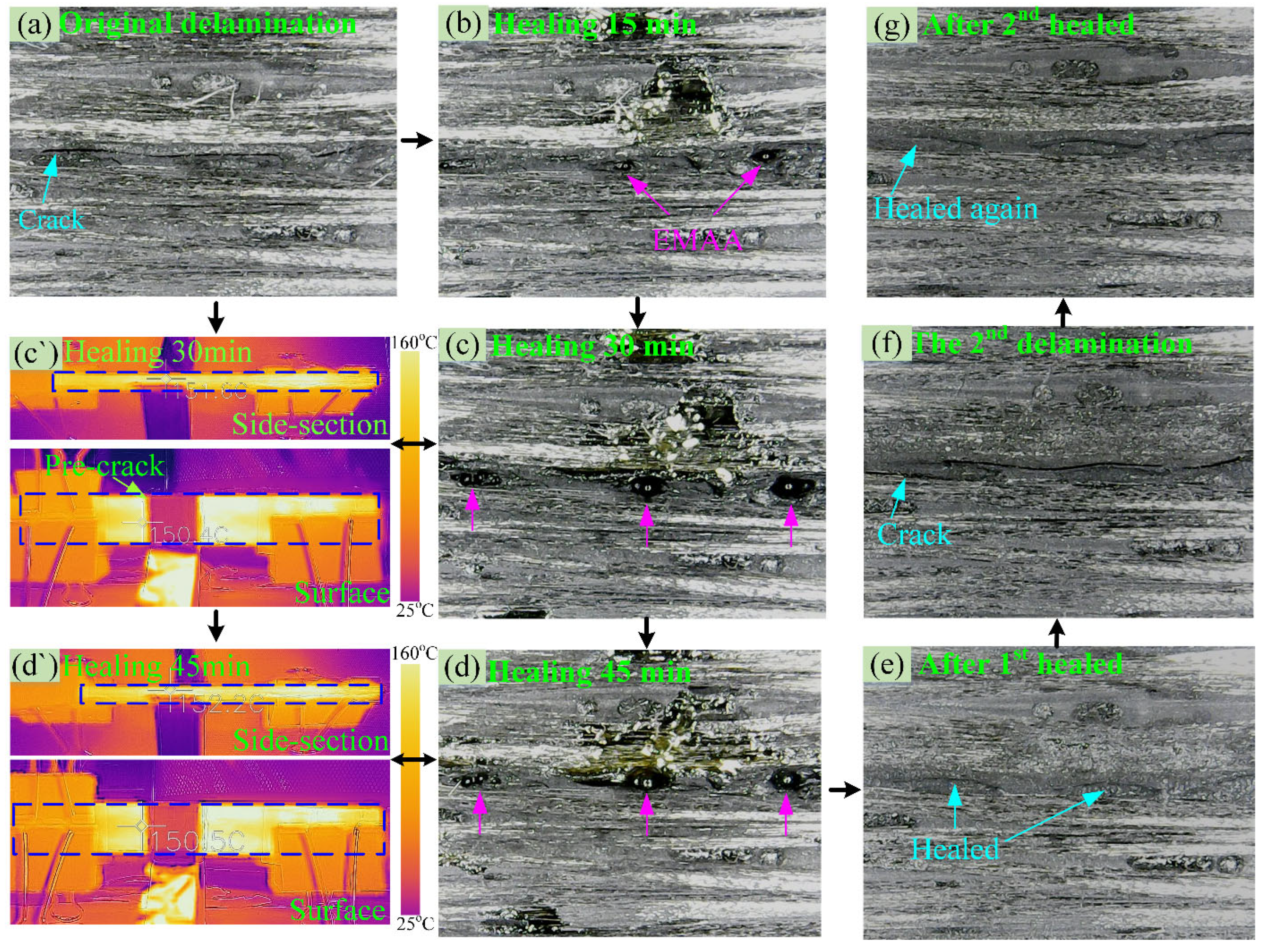
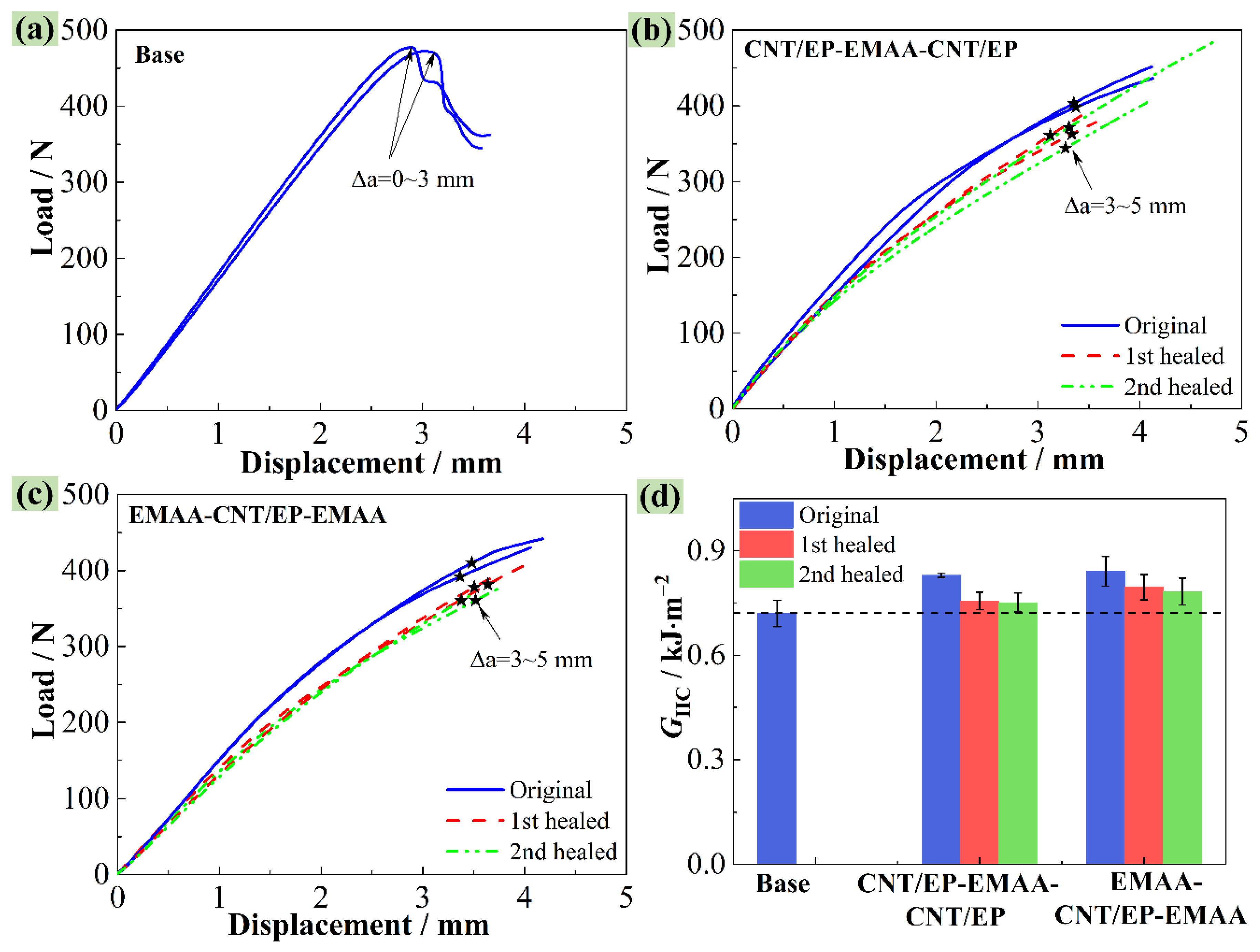
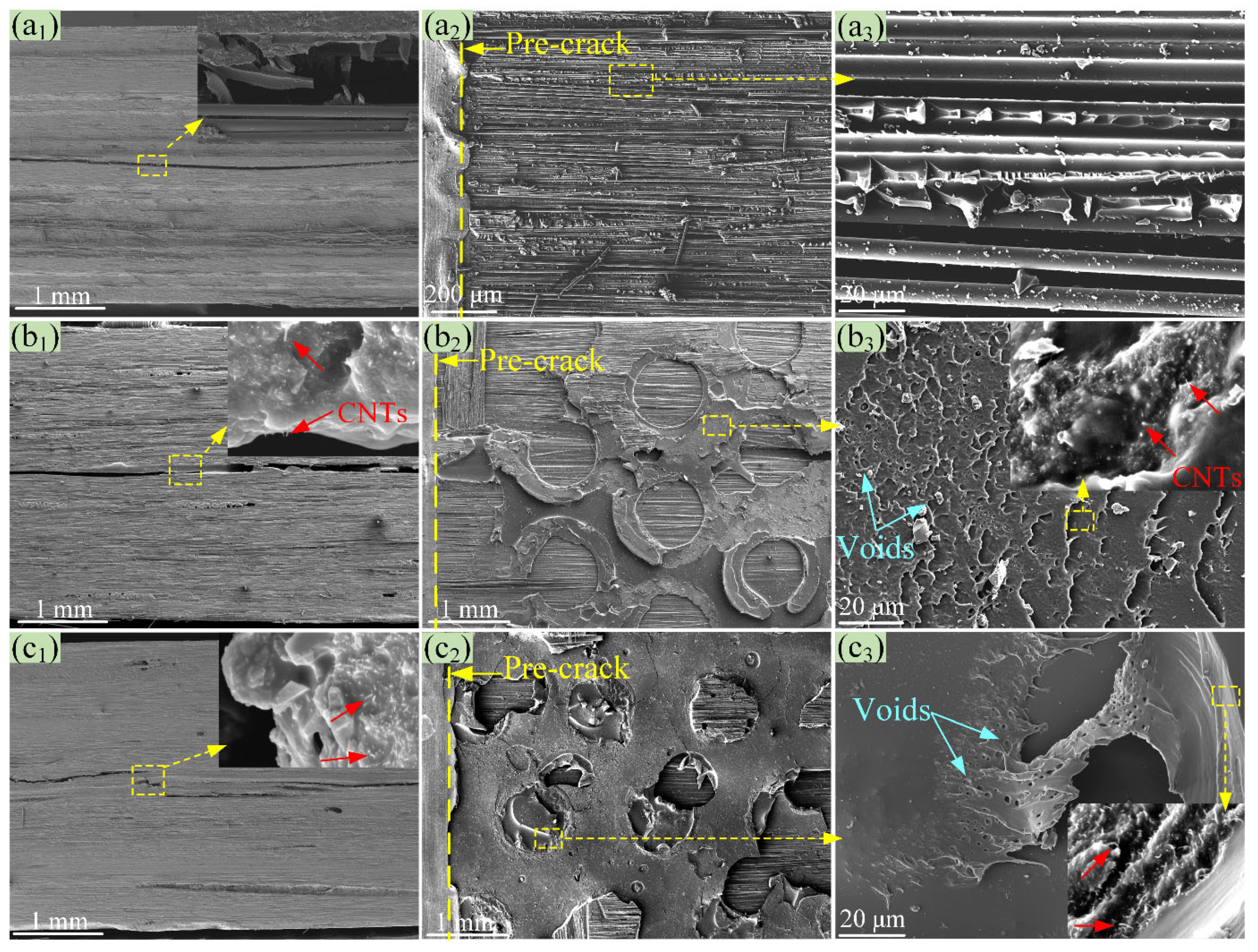
Publisher’s Note: MDPI stays neutral with regard to jurisdictional claims in published maps and institutional affiliations. |
© 2022 by the authors. Licensee MDPI, Basel, Switzerland. This article is an open access article distributed under the terms and conditions of the Creative Commons Attribution (CC BY) license (https://creativecommons.org/licenses/by/4.0/).
Share and Cite
Ouyang, Q.; Liu, L.; Wu, Z. Electrothermally Self-Healing Delamination Cracks in Carbon/Epoxy Composites Using Sandwich and Tough Carbon Nanotube/Copolymer Interleaves. Polymers 2022, 14, 4313. https://doi.org/10.3390/polym14204313
Ouyang Q, Liu L, Wu Z. Electrothermally Self-Healing Delamination Cracks in Carbon/Epoxy Composites Using Sandwich and Tough Carbon Nanotube/Copolymer Interleaves. Polymers. 2022; 14(20):4313. https://doi.org/10.3390/polym14204313
Chicago/Turabian StyleOuyang, Qin, Ling Liu, and Zhanjun Wu. 2022. "Electrothermally Self-Healing Delamination Cracks in Carbon/Epoxy Composites Using Sandwich and Tough Carbon Nanotube/Copolymer Interleaves" Polymers 14, no. 20: 4313. https://doi.org/10.3390/polym14204313
APA StyleOuyang, Q., Liu, L., & Wu, Z. (2022). Electrothermally Self-Healing Delamination Cracks in Carbon/Epoxy Composites Using Sandwich and Tough Carbon Nanotube/Copolymer Interleaves. Polymers, 14(20), 4313. https://doi.org/10.3390/polym14204313






